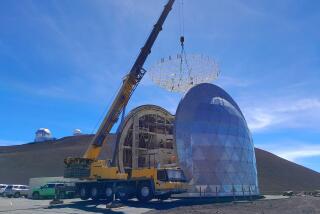The lure of Mauna Kea
- Share via
HILO, Hawaii — About 11,000 feet up Mauna Kea, a dormant volcano on the Big Island of Hawaii, a plaintive-looking young couple stood by the side of the road, their thumbs thrust out.
Tied around the woman’s waist was a yellow sweater as bright as the plumage on a canary that contrasted with the black lava landscape. She and her companion were impossible to miss.
Yet I didn’t stop. On Hawaii, hitchhiking might be common, but getting the car started again would have been a feat, not unlike the couple’s efforts to reach the 13,796-feet summit on foot.
Only a handful of visitors are rewarded by making it to the top, home to a cluster of international observatories, partly because the University of Hawaii, which manages the mountain, does a good job of discouraging tourists.
“We try not to encourage too much visitation up there,” said Stewart Hunter, a manager at the remote research site, citing the sacred nature of the peak to native Hawaiians, its fragile environment and the rare Wekiu bug that calls it home.
But probably his biggest worry is having to mollycoddle day-trippers who face rapidly changing weather — snow, ice and 20-degree temperatures are common winter companions — and the challenging drive that can damage a rental car.
The visitor center, at 9,000 feet and accessible by paved road, has guides. Prominent signage urges guests who want to venture higher — the summit is the highest point in the state — to use a four-wheel-drive vehicle or turn around.
It is sage but sometimes ignored advice.
Much of the eight-mile stretch of narrow roadway from the visitor center to the astronomers’ lofty perches is unpaved. The mix of sand and gravel plus the steep incline challenge even experienced drivers as they inch upward in first and second gears.
On a clear day, the views from the top are awe-inspiring. Below the sparse clouds lay the verdant farms and ranches that hug the Saddle Road linking Hilo and Waimea.
SUVs are parked outside of the towering observatories where, inside, scientists are gazing through their telescopes.
For independent travelers interested in learning more, the W.M. Keck Observatory has a visitor gallery, open 9:30-4 p.m. Mondays-Fridays. Exhibits describe its research and operations as well as a viewing area with partial views of the Keck 1 telescope and dome.
On Saturday and Sunday afternoons, those interested in reaching the summit can meet at 1 p.m. at the visitor center — officially the Visitor Information Station of the Onizuka Center for International Astronomy — where they can caravan to the top. It’s free, but visitors must have a four-wheel-drive vehicle, must be at least 16 and must not be pregnant.
“These regulations are strictly enforced,” the Mauna Kea website says.
Although I’m not a fan of organized tours, a friend told me that for Mauna Kea such an excursion is the correct choice both for the information and for the safety it provides.
“It makes a difference … just being able to relax and not worry about the drive,” said Rob Pacheco, founder of Hawaii Forest & Trail.
His company’s Summit & Stars tour, using customized four-wheel-drives, begins in late afternoon to reach the top of the volcano for sunset. On the return journey, there’s a stop in the near-total darkness, during which guides provide telescopes for stargazing.
On my way down the mountain, in broad daylight, I spotted the couple climbing into the back seat of a convertible on its way to the top. Fortunately, the driver had encountered them on a rare, flat stretch of roadway where he could stop.
I was admittedly relieved — and redeemed too — knowing that they would be among our elite group of conquerors of this unique peak.
More to Read
Sign up for The Wild
We’ll help you find the best places to hike, bike and run, as well as the perfect silent spots for meditation and yoga.
You may occasionally receive promotional content from the Los Angeles Times.






